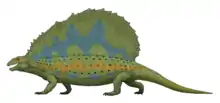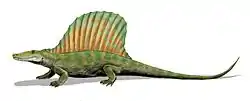Ruthenosaurus
Ruthenosaurus is an extinct genus of large caseid synapsids from Early (Artinskian-Kungurian) or Middle (Roadian-Wordian) Permian deposits of southern France. It is known from the holotype MNHN.F.MCL-1 an articulated partial postcranial skeleton. It was collected by D. Sigogneau-Russell and D. Russell in 1970 in the upper part of the M2 Member, Grès Rouge Group, in the Rodez Basin, near the village of Valady (département of Aveyron), in Occitanie Region. It was first named by Robert R. Reisz, Hillary C. Maddin, Jörg Fröbisch and Jocelyn Falconnet in 2011, and the type species is Ruthenosaurus russellorum.[1]
| Ruthenosaurus | |
|---|---|
| Scientific classification | |
| Kingdom: | Animalia |
| Phylum: | Chordata |
| Clade: | †Caseasauria |
| Family: | †Caseidae |
| Genus: | †Ruthenosaurus Reisz et al., 2011 |
| Species | |
Etymology
Ruthenosaurus is named after a Gallic regional tribe, Ruthenie (in Medieval Latin), that have also given Ruthénois, the name of the inhabitants of the town of Rodez; and the Ancient Greek sauros, "lizard".[1] The type species is named in honour of Drs Denise Sigogneau-Russell and Donald E. Russell, the original collectors of the holotype.[1]
Discovery
The holotype of Ruthenosaurus was discovered in the summer 1970 by the paleontologists Denise Sigogneau-Russell and Donald Eugene Russell, during a prospecting survey carried out in Permian red sandstones outcropping in badlands on the western flank of the Cayla Hill near the commune of Valady, northwest of Rodez.[2] An eroded vertebra picked up on the western slope of the hill led the scientists to explore the surrounding canyons, where they discovered a large articulated skeleton still in place in the sediments but damaged by erosion.[2] The skull, neck, most of the limbs, and the tail were missing, probably destroyed by erosion. The known material includes ribs and vertebrae of 18 presacrals, three sacrals, and 12 anterior caudals; incomplete scapulocoracoids and interclavicule; right humerus badly crushed and damaged; left humerus in two pieces, shaft damaged, but proximal and distal heads well preserved; complete left ulna and nearly complete radius; complete right femur, complete right tibia, and proximal portion of right fibula; and the complete right pelvis overlain by vertebral column. On the southeastern flank of the same hill, but in older strata, the same team discovered the anterior part of a skeleton (including the skull) belonging to a smaller animal. This specimen was first assigned to a new species of the genus Casea, Casea rutena.[2] But it is now regarded as a distinct genus named Euromycter, with the new combination Euromycter rutenus.[1] The larger skeleton, found stratigraphycally 120 meters above the Euromycter level, remained largely unprepared until 2003. The few overlapping elements with Euromycter suggested that it belongs to a different taxon named Ruthenosaurus russellorum in 2011.[1]
Description
Ruthenosaurus is diagnosed by several autapomorphies including dorsal vertebrae with anteriorly tilting neural spines and a diamond-shaped outline in transverse section; a first sacral rib with robust distal head, twice that of the second sacral rib; and a short iliac blade with prominent posterior process. It can be distinguished from Euromycter, from older deposits of the same locality, by the shape of the distal part of the humerus, including an ectepicondylar notch rather than a fully enclosed foramen, the specific shape of the ulna, and the overall robustness of the specimen.[1]
The lack of fusion of the neural arches with their respective vertebral centra and incomplete ossification of the ends of the limb elements, including the absence of an ossified olecranon on the ulna, show clearly that this specimen represents a juvenile individual. However, it is distinctly larger than the fully mature specimen of Euromycter, suggesting a very large size for adult Ruthenosaurus.[1]
Stratigraphic range
The holotype of Ruthenosaurus was found in the uppert part of the red pelitic beds of the M2 Member, which belongs to the Grès Rouge (“Red Sandstone”) Group, a sedimentary sequence subdivided into five hectometric members (M1 to M5) localized in the western Rodez basin. Like the M1 Member that has yielded Euromycter, the deposits of the M2 Member are interpreted as a playa-lake environment (or Sabkha) under a semi-arid, hot climate.[1] The age of the Grès Rouge Group is uncertain but it is regarded as contemporaneous to the Saxonian Group of the neighbourhing Lodève basin, where radiometric and magnetostratigraphic data suggested previously an age between the late Sakmarian (middle of the Early Permian) and the early Lopingian (early Late Permian).[3][1] However, new chronostratigraphic and magnetostratigraphic data for the Saxonian Group indicate an age between the Artinskian (for the Rabejac Formation and the Octon Member of the Salagou Formation) and the Roadian-Wordian (for La Lieude Formation).[4][5] Unfortunately, there is no evidence for a more precise correlation of the M1 to M5 members of the Grès Rouge Group with the Rabejac, Salagou and La Lieude formations of the Saxonian Group.[1] So the age of Ruthenosaurus is somewhere between the late Early Permian and the early to mid-Middle Permian. It’s only possible to say that it comes from younger rocks than Euromycter.
Classification
The first phylogenetic analysis of the caseids containing Ruthenosaurus was made by Romano & Nicosia in 2015. In their most parsimonious analysis including nearly all caseids (to the exclusion of the very fragmentary Alierasaurus ronchi from Sardinia), Ruthenosaurus is found very close to Cotylorhynchus and most specifically to the giant Cotylorhynchus hancocki. However, Romano & Nicosia have concluded that given the large body size of the two taxa and considering the absence of cranial material for Ruthenosaurus, it is possible that their close similarity is size related.[6]
Below the most pasimonious phylogenetic analysis published by Romano & Nicosia in 2015.[6]
| Caseasauria |
| ||||||||||||||||||||||||||||||||||||||||||||||||||||||||||||||||||||||||||||||
References
- Reisz, R.R.; Maddin, H.C.; Fröbisch, J.; Falconnet, J. (2011). "A new large caseid (Synapsida, Caseasauria) from the Permian of Rodez (France), including a reappraisal of "Casea" rutena Sigogneau-Russell & Russell, 1974". Geodiversitas. 33 (2): 227–246.
- Sigoneau-Russell, D.; Russel, D.E. (1974). "Étude du premier caséidé (Reptilia, Pelycosauria) d'Europe occidentale". Bulletin du Muséum national d'Histoire naturelle Série 3. 38 (230): 145–215.
- Lopez, M.; Gand, G.; Garric, J.; Körner, F.; Schneider, J. (2008). "The playa environments of the Lodève Permian Basin (Languedoc-France)". Journal of Iberian Geology. 34 (1): 29–56.
- Evans, M.E.; Pavlov, V.; Veselovsky, R.; Fetisova, A. (2014). "Late Permian paleomagnetic results from the Lodève, Le Luc, and Bas-Argens Basins (southern France): magnetostratigraphy and geomagnetic field morphology". Physics of the Earth and Planetary Interiors. 237: 18–24. doi:10.1016/j.pepi.2014.09.002.
- Michel, L.A.; Tabor, N.J.; Montañez, I.P.; Schmitz,M.; Davydov, V.I. (2015). "Chronostratigraphy and paleoclimatology of the Lodève Basin, France: evidence for a pan-tropical aridification event across the Carboniferous-Permian boundary". Palaeogeography, Palaeoclimatology, Palaeoecology. 430: 118–131. doi:10.1016/j.palaeo.2015.03.020.
- Romano, M.; Nicosia, U. (2015). "Cladistic analysis of Caseidae (Caseasauria, Synapsida): using the gap-weighting method to include taxa based on incomplete specimens". Palaeontology. 58 (6): 1109–1130. doi:10.1111/pala.12197.



